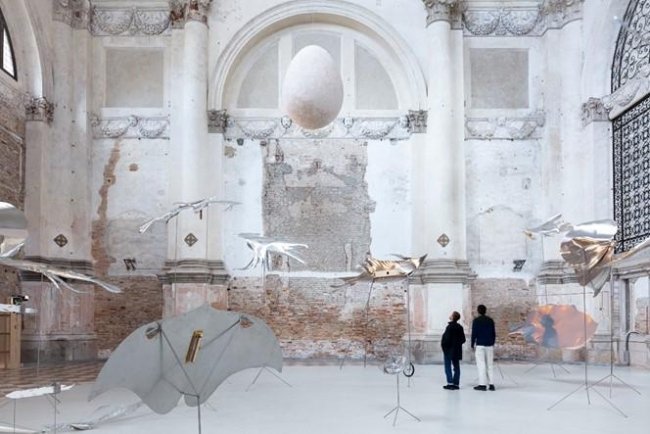
Petrit Halilaj & Álvaro Urbano. Lunar Ensemble for Uprising Seas
Inspired by Ay mi pescadito, a popular Spanish song about young fish studying forms of survival and belonging, this immersive work addresses concepts of cohesion and disharmony among species.
Lunar Ensemble for Uprising Seas creates an evolving ecosystem comprising over 40 large-scale sculptures depicting whimsical, hybrid aquatic, terrestrial, and aerial creatures that do not exist in the real world. The works, which will include new sculptures for this presentation, range in scale and offer creative interpretations of future states of evolution, including survival both underwater and in the sky. Above the creatures, a large egg-shaped sculpture is suspended from the ceiling and floats above the space, symbolizing the cyclical nature of our world and encouraging visitors to reimagine future forms of life.
Set within MACBA’s expansive three-floor atrium, the sculptures’ metallic skins reflect the sunlight onto the museum’s walls, ceilings, and floors, modifying the perception of the space over the day. Each sculpture doubles as a musical instrument, producing sounds from music boxes and other DIY techniques. When played together, the music boxes and other instruments attempt a “melody” inspired by Ay mi pescadito combined with underwater noises. These sounds do not easily harmonise, mirroring the complexity of creating perfect synchrony among species in the material world.
Petrit Halilaj (1986, Kostërrc-Skenderaj, Kosovo) and Álvaro Urbano (1983, Madrid, Spain) have developed a joint practice since 2014, intermixing their individual artistic careers and their shared personal lives. The artists approach their duo work as a way of expressing the intricacies of how the private and the public collide and influence each other as fluid dimensions. Halilaj and Urbano are constantly creating a collaborative fiction through their duo work: collective memory blends with personal anecdotes, and utopian thinking is triggered by imagining how the idea of kinship expands beyond the human: Plants and animals takeover, becoming elements of the theatrics of intimacy. The artists have staged performances in which raccoons, foxes, seagulls, as well as imagined hybrid creatures are the main characters, surrounded by blown-up flowers and environments that activate spaces of resilience and resistance through the celebration of otherness. Queerness and intimacy are key aspects of the artists’ work: they exercise them as means of world-making. With each project, they reconsider the normative aspect of society, offering alternatives that trigger spaces of negotiation in which collective memory and social expectations can be reconfigured.

